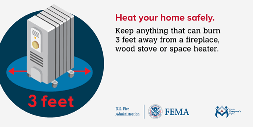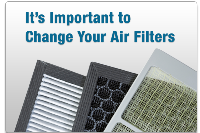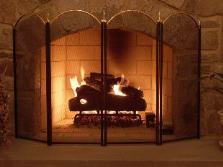With colder weather approaching, it is time to think about heating our homes safely.

One of the most important aspect of home fire safety is making sure that every home has a working smoke detector (Smoke Alarm Safety), and that these detectors are checked monthly and batteries are changed annually.
Carbon Monoxide alarms (Carbon Monoxide Safety) are easy to install and can save lives. They do not take the place of a Smoke Alarms; however, having one is the next step to a safe environment in the home. Any open flame heater creates Carbon Monoxide gas and if your heating devices in the home are not functioning properly, this gas can be deadly. They are becoming more affordable, more effective and if you have a flame operated heating device in your home, indispensable.
Heat Sources
According to the United States Fire Association (USFA), thirty percent of the non-confined home heating fires occur because the heat source was too close to things that can burn. Those fire confined to chimneys, flues or fuel burners account for 87%.
Space Heaters

- Make sure the heater has automatic shut-off, so if it tips over, it shuts off.
- Turn heaters off when you go to bed or leave the room
- Never plug into an extension cord or power strip.
- Only use portable heaters from a recognized testing laboratory.
- Dust and lint may have accumulated in the space heater. Be sure to clean them thoroughly with a vacuum cleaner.
- Gas space heaters need to have the flame adjusted to blue in order to reduce the risk of carbon monoxide build up.
- Caution children not to stand too close to a space heater to warm up, as their clothing could catch fire.
- Give space heaters their space! Keep anything that can burn, such as bedding, clothing curtains and other combustible material away; at least 3′ in all directions.
Furnaces
Floor Furnaces
- Floor furnaces are safest when they are equipped with a thermostat and automatic shut off device.
- Clean the floor furnace by removing the grate and using a vacuum to remove dust and lint from inside the unit.
- During the summer months, people often place throw rugs on the floor furnace. As the weather cools, they may remove these rugs and turn the furnace on. During the warm days following a cold snap, people often throw the rug back onto the furnace without turning the unit off. Then, when it becomes cold again, the floor furnace automatically comes back on igniting the throw rug. Be sure to remove rugs whenever the unit is switched on.

Central Heaters
- Have your furnace inspected each year.
- Clean or replace the furnace filter.
- Clean the entire furnace area using a vacuum to remove dust and lint.
- Keep anything that can burn away from the furnace.
Fireplaces and Wood Stoves

More than one-third of American use fireplaces, wood stoves and other fuel-fired appliances as primary heat sources in their homes. Unfortunately, many people are unaware of the fire risks when heating with wood and solid fuels.
Practicing the following safety steps to keep those home fires safely burning: Fireplace & Wood Stove Safety
There are many potential problems when we are heating our homes during the cooler months. If you need professional assistance with heating equipment preparation, look in the Yellow Pages under “Heating Contractors” or “Chimney Cleaning”. With a little caution, we can all remain safe and healthy during the fall and winter season.
*Sources: United States Fire Administration (USFA) and the Environmental Protection Agency (EPA)*
